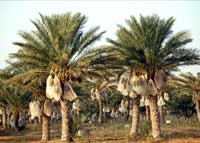Nurturing Nature’s Sweets: Understanding the Perfect Climate for Dates
Embark on a journey into the heart of date cultivation as we unravel the nuances of the ideal climate for growing dates. In this comprehensive guide, discover the critical factors that contribute to successful date farming, ensuring the sweetest and most succulent fruit harvest.
The Essential Elements: Factors Influencing Date Climate
1. Temperature Matters: Warmth and Sunshine
The ideal climate for date cultivation is characterized by warm temperatures and abundant sunshine. Dates thrive in regions where temperatures range between 85°F to 105°F (29°C to 40°C), allowing for optimal growth and fruit development.
2. Low Humidity, High Dryness
Dates prefer low humidity levels and thrive in arid conditions. Dry climates with minimal rainfall during the fruiting season are ideal, as excessive humidity can lead to issues like fruit rot and hinder the overall quality of the harvest.
3. Chilling Hours for Optimal Growth
Certain date varieties benefit from a period of chilling hours during the winter months, where temperatures drop to around 45°F (7°C). This chilling requirement helps break dormancy and contributes to healthier palm growth and fruiting.
Date Varieties and Climate Adaptations
1. Medjool Dates: Thriving in Desert Sun
Medjool dates, known for their large size and rich flavor, thrive in hot and arid climates. Originating from the deserts of Morocco, Medjool palms have adapted to intense sunlight and warm temperatures, making them well-suited for similar environments worldwide.
2. Barhi Dates: Embracing the Desert Heat
Barhi dates are another variety that flourishes in hot climates. These palms are resilient to high temperatures and are often cultivated in regions with long, scorching summers, such as those found in North Africa and the Middle East.
Understanding Microclimates for Date Cultivation
Understanding microclimates within a region is crucial for successful date cultivation. Factors such as altitude, proximity to bodies of water, and local weather patterns can influence the suitability of a specific area for date palm growth.
Climate Challenges and Mitigation Strategies
1. Protecting Against Frost
In regions with occasional frost, protective measures such as frost cloth or wind machines may be employed to shield date palms from cold temperatures that can damage fronds and young fruit.
2. Irrigation Management in Dry Climates
In extremely dry climates, proper irrigation management is essential. Drip irrigation systems and efficient water use help ensure that date palms receive the necessary moisture for healthy growth, even in arid conditions.
Sustainable Practices for Date Climate Management
1. Organic Soil Amendments
Incorporating organic soil amendments enhances the soil structure and water retention capabilities, contributing to sustainable date farming practices in various climates.
2. Precision Agriculture Techniques
Adopting precision agriculture techniques, such as remote sensing and data analytics, allows farmers to monitor and optimize crop conditions based on real-time climate data, promoting resource efficiency.
Adapting to Climate Change: Future-Proofing Date Agriculture
1. Research and Innovation
Ongoing research and innovation in agriculture aim to develop date palm varieties that are more resilient to changing climate conditions, ensuring the sustainability of date cultivation for future generations.
2. Climate-Smart Agriculture Practices
Implementing climate-smart agriculture practices, such as water conservation, efficient resource use, and sustainable land management, is essential for mitigating the impact of climate change on date farming.
Climate Harmony: Ensuring the Sweet Success of Date Cultivation
In conclusion, the success of date cultivation is intricately linked to climate conditions. By understanding the ideal climate requirements, adapting to regional challenges, and embracing sustainable practices, we can ensure the continued abundance of nature’s sweetest treasures. Here’s to achieving climate harmony for thriving date palms and bountiful harvests.
Commercial fruit production is possible only where there is a long, hot growing season with daily maximum temperatures of 90°F (32.22°C) and virtually no rain—less than 1/2 in (1.25 cm) in the ripening season.

